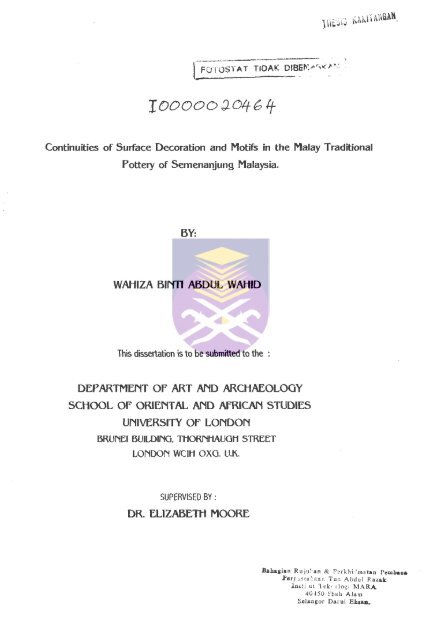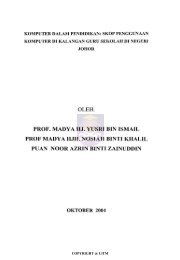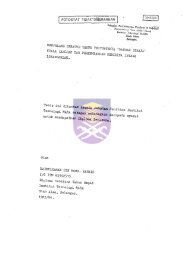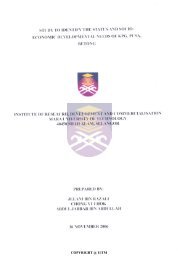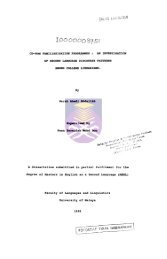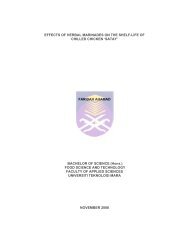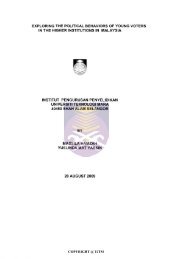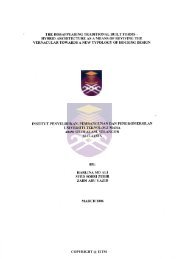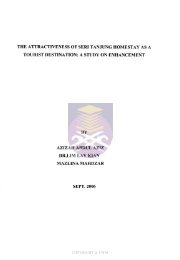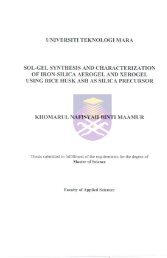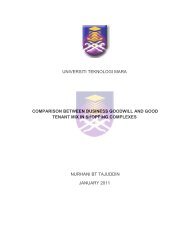Continuities of Surface Decoration and Motifs in the Malay ...
Continuities of Surface Decoration and Motifs in the Malay ...
Continuities of Surface Decoration and Motifs in the Malay ...
You also want an ePaper? Increase the reach of your titles
YUMPU automatically turns print PDFs into web optimized ePapers that Google loves.
FOTOSTAT TIOAK<br />
<strong>Cont<strong>in</strong>uities</strong> <strong>of</strong> <strong>Surface</strong> <strong>Decoration</strong> <strong>and</strong> <strong>Motifs</strong> <strong>in</strong> <strong>the</strong> <strong>Malay</strong> Traditional<br />
Pottery <strong>of</strong> Semenanjung <strong>Malay</strong>sia.<br />
BY:<br />
WAHIZA BINTI ABDUL WAHID<br />
This dissertation is to be submitted to <strong>the</strong> :<br />
DEPARTMENT OF ART AND ARCHAEOLOGY<br />
SCHOOL OF ORIENTAL AND AFRICAN STUDIES<br />
UNIVERSITY OF LONDON<br />
BRUNEI BUILDING, THORNHAUGH STREET<br />
LONDON WC1H OXG. UK.<br />
SUPERVISED BY:<br />
DR. ELIZABETH MOORE<br />
Bahagian Ruju! an & Perkhi'matan Pcmb«g»<br />
JPerFusra!:a3r. Tun Abdu! FUzak<br />
Insti ut 'Ukfologi MARA<br />
40450 i'bah Alam<br />
Sclangor Darul Ehaao.
COPYRIGHT © UiTM<br />
Bahagmn * , •.',; ;':;r^li : . .Man Pembaca,<br />
Pr; . . i • ' = ('-, Abdu! i'azafc<br />
,,, -. jt :.,\: -.c.losi MARA.<br />
40450 Shah Alam<br />
Darul
ABSTRACT 1<br />
ACKNOWLEDGEMENTS 3<br />
CHAPTER 1<br />
• A Brief History <strong>of</strong> Semenanjung <strong>Malay</strong>sia 5<br />
• The Def<strong>in</strong>ition <strong>of</strong> Motif <strong>and</strong> <strong>Decoration</strong> 9<br />
• History <strong>of</strong> <strong>the</strong> Early <strong>Malay</strong> Traditional <strong>Decoration</strong> 11<br />
CHAPTER 2<br />
• The Concept <strong>and</strong> Aes<strong>the</strong>tic value <strong>of</strong> Traditional <strong>Malay</strong> Craft 14<br />
• The Concept <strong>of</strong> Traditional Art (Creation) 19<br />
• History <strong>and</strong> Discoveries <strong>of</strong> Pottery <strong>in</strong> Semenanjung <strong>Malay</strong>sia 20<br />
CHAPTER 3<br />
• Forms <strong>and</strong> Utilitarian Functions <strong>of</strong> Pottery <strong>in</strong> Semenanjung 30<br />
• Utilitarian Function 37<br />
• Classification <strong>of</strong> Form 39<br />
• <strong>Surface</strong> <strong>Decoration</strong>s <strong>and</strong> <strong>Motifs</strong> 40<br />
• Pr<strong>in</strong>ciple <strong>of</strong> <strong>Decoration</strong> on Pottery <strong>in</strong> Semenanjung 48<br />
• Geometrical motifs 50<br />
• Organic form 50<br />
• Comb<strong>in</strong>ation <strong>of</strong> geometrical <strong>and</strong> organic forms 51<br />
• Islamic Cosmology <strong>and</strong> motifs <strong>in</strong> <strong>the</strong> Traditional <strong>Malay</strong> art 51<br />
• Process <strong>of</strong> Production - Traditional <strong>Malay</strong> Pottery 59<br />
CHAPTER 4<br />
• The Future Ceramics <strong>in</strong> <strong>Malay</strong>sia <strong>and</strong> <strong>the</strong>ir potential 60<br />
• Towards <strong>the</strong> Challenge <strong>and</strong> Development <strong>of</strong> Pottery <strong>in</strong> Semenanjung <strong>Malay</strong>sia 65<br />
• Conclusion 69<br />
GLOSSARY 72<br />
BIBLIOGRAPHY 76<br />
COPYRIGHT © UiTM
Abstract<br />
The purpose <strong>of</strong> this dissertation is to observe <strong>the</strong> surface decoration <strong>and</strong> motifs found on<br />
<strong>the</strong> pottery <strong>of</strong> Semenanjung <strong>Malay</strong>sia. By observ<strong>in</strong>g <strong>the</strong> history <strong>of</strong> motifs <strong>and</strong> surface decoration, we<br />
may <strong>in</strong>directly discover when <strong>the</strong>y began to be used, especially on pottery <strong>in</strong> Semenanjung. We<br />
should also consider <strong>the</strong> possibilities <strong>of</strong> outside <strong>in</strong>fluences on this pottery <strong>in</strong> order to underst<strong>and</strong><br />
where <strong>the</strong> motifs derive from.<br />
<strong>Malay</strong> Traditional pottery can be categorised as 'ear<strong>the</strong>nware'. The creation <strong>of</strong> this pottery<br />
has its own identity <strong>and</strong> value that reflect <strong>the</strong> form <strong>and</strong> soul <strong>of</strong> <strong>Malay</strong> culture. Especially motifs<br />
based on nature that are used widely <strong>in</strong> Semenanjung may be related to appreciation <strong>of</strong> nature.<br />
There are also possibilities that <strong>the</strong> designs <strong>and</strong> motifs found are <strong>in</strong>fluenced by Islamic<br />
countries, such as Persia. This probably occurred through religious <strong>and</strong> cultural exchanges brought<br />
by Muslim traders. This is demonstrated by <strong>the</strong> fact that <strong>the</strong>se motifs are <strong>in</strong> use extensively not only<br />
on pottery, but also <strong>in</strong> o<strong>the</strong>r traditional crafts, such as weav<strong>in</strong>g <strong>and</strong> carv<strong>in</strong>g.<br />
The aes<strong>the</strong>tic value <strong>of</strong> <strong>the</strong> <strong>Malay</strong> community comes from <strong>in</strong>ner feel<strong>in</strong>gs. Never<strong>the</strong>less,<br />
physical sensation <strong>and</strong> ideas are also important for <strong>the</strong> assessment <strong>of</strong> aes<strong>the</strong>tics <strong>in</strong> <strong>the</strong> community.<br />
There are three different characteristics that <strong>in</strong>fluence <strong>Malay</strong> community <strong>in</strong> assess<strong>in</strong>g <strong>the</strong> aes<strong>the</strong>tic<br />
value <strong>of</strong> an art object. They are; gentieness, unity <strong>and</strong> orig<strong>in</strong>ality. The com<strong>in</strong>g <strong>of</strong> Islam enhanced<br />
COPYRIGHT © UiTM
Abstract 2<br />
pre-exist<strong>in</strong>g o<strong>the</strong>r <strong>Malay</strong> values such as ethics, functionality <strong>and</strong> simplicity. Islam encourages<br />
everyone to value <strong>the</strong> aes<strong>the</strong>tic <strong>of</strong> an object <strong>in</strong> relation to aft <strong>the</strong>se aspects. Never<strong>the</strong>less, (slam<br />
forbids representation <strong>of</strong> human figures <strong>in</strong> art To this factor, <strong>the</strong> Matey artists <strong>and</strong> craftsmen <strong>in</strong><br />
Semenanjung are cont<strong>in</strong>uously creat<strong>in</strong>g <strong>and</strong> us<strong>in</strong>g geometrical <strong>and</strong> organic motifs <strong>in</strong> <strong>the</strong>ir work <strong>of</strong><br />
art<br />
In this dissertation, I shall study <strong>and</strong> br<strong>in</strong>g forward <strong>the</strong> motifs commonly applied on <strong>the</strong><br />
pottery works especially <strong>in</strong> Semenanjung. I shaft also try to look at <strong>the</strong> possibilities <strong>of</strong> outside<br />
<strong>in</strong>fluences. Most <strong>of</strong> <strong>the</strong> terms to be used <strong>in</strong> this dissertation would be <strong>in</strong> Bahasa Melayu (Bahasa<br />
<strong>Malay</strong>sia) <strong>and</strong> will be clarified <strong>in</strong> <strong>the</strong> glossaries.<br />
COPYRIGHT © UiTM
Acknowledgements<br />
FLCbQCTOTJ<br />
The substance for this paper is orig<strong>in</strong>ally to be submitted to <strong>the</strong> Department <strong>of</strong> Art <strong>and</strong><br />
Archaeology, School <strong>of</strong> Oriental <strong>and</strong> African Studies, University <strong>of</strong> London, as a dissertation for <strong>the</strong><br />
M.A. Programme.<br />
Rrst <strong>and</strong> foremost, I wish to express my s<strong>in</strong>cere appreciation <strong>and</strong> gratitude to my academic<br />
supervisor, Pr<strong>of</strong>essor Dr. Elizabeth Moore. Without her guidance, op<strong>in</strong>ion <strong>and</strong> criticism, I could not<br />
have completed my dissertation. My special thanks are also due to Pr<strong>of</strong>essor Dr. Othman Mohd.<br />
Yatim, <strong>the</strong> Director <strong>of</strong> Museum <strong>of</strong> Asian Art, University <strong>of</strong> <strong>Malay</strong>s, <strong>Malay</strong>sia for his strong<br />
encouragement <strong>and</strong> advice <strong>and</strong> who assisted me with <strong>in</strong>formation <strong>in</strong> various ways. Pr<strong>of</strong>essor Dr.<br />
Othman Mohd. Yatim too had permitted <strong>and</strong> recommended me to ga<strong>the</strong>r <strong>in</strong>formation <strong>and</strong> to do<br />
researches at <strong>the</strong> Museum <strong>of</strong> Taip<strong>in</strong>g, Perak, dur<strong>in</strong>g my one month Easter vacation <strong>in</strong> <strong>Malay</strong>sia.<br />
(March-April 1997).<br />
A number <strong>of</strong> lecturers <strong>in</strong> <strong>the</strong> Mara Institute <strong>of</strong> Technology, Shah Alam, Selangor Darul<br />
Ehsan, <strong>Malay</strong>sia too need my appreciation. Among <strong>the</strong>m are Puan Jahani Ali, Pr<strong>of</strong>essor Madya Ham<br />
Rabeah Kamarun, <strong>and</strong> Puan Faridah Mohd. Yus<strong>of</strong>f, who were k<strong>in</strong>d enough to give me support <strong>and</strong><br />
op<strong>in</strong>ion all along complet<strong>in</strong>g my M.A. <strong>in</strong> SOAS. Also, to Pr<strong>of</strong>essor Madya Ungku Maimunah Mohd.<br />
Tahir, from University Kebangsaan <strong>Malay</strong>sia, who had been <strong>in</strong> SOAS on sabatical<strong>and</strong><br />
COPYRIGHT © UiTM
Acknowledgements<br />
Mr. D<strong>in</strong>ar Boontharm, my classmate who had k<strong>in</strong>dly helped me build<strong>in</strong>g up my spirit <strong>and</strong> enthusiasm<br />
on complet<strong>in</strong>g my dissertation.<br />
Formally, I wish to acknowledge <strong>the</strong> scholarship granted to me by Mara Institute <strong>of</strong><br />
Technology, under <strong>the</strong> Young Lecturer Scheme (1996 -1997), without which, I would probably not<br />
have been able to attempt this study.<br />
Last, but not least, not forgett<strong>in</strong>g to acknowledge <strong>the</strong> very lov<strong>in</strong>g support <strong>of</strong> my mom,<br />
Madam Hajah Maznah Abdul Manaf, sister, Wahida, Zonariah <strong>and</strong> Kart<strong>in</strong>i, bro<strong>the</strong>rs Mazlan, Mohd.<br />
Taha <strong>and</strong> Ruslan, who helped me keep<strong>in</strong>g up my enthusiasm <strong>and</strong> showed <strong>the</strong>ir concern <strong>and</strong><br />
underst<strong>and</strong><strong>in</strong>g, my niece, Nur Nadia Idlani <strong>and</strong> nephews, Nadzr<strong>in</strong> Azrai, Muhd. Zhafir<strong>in</strong> <strong>and</strong><br />
Muhammad Amir, who are a cont<strong>in</strong>ual source <strong>of</strong> <strong>in</strong>spiration.<br />
48, KENSINGTON AVENUE,<br />
MANOR PARK,<br />
LONDON El 2 6NP<br />
6 SEPTEMBER 97<br />
COPYRIGHT © UiTM<br />
m. n c
Chapter 1<br />
A Brief History <strong>of</strong> Semenanjung <strong>Malay</strong>sia<br />
INTRODUCTION<br />
It rema<strong>in</strong>s a question as to how <strong>the</strong> Proto <strong>Malay</strong> race became <strong>the</strong> civilised people who now<br />
populate <strong>the</strong> <strong>Malay</strong> Pen<strong>in</strong>sula, Sumatra <strong>and</strong> o<strong>the</strong>r isl<strong>and</strong>s. Generally, historians presume that<br />
<strong>in</strong>termarriage with o<strong>the</strong>r tribes <strong>in</strong> <strong>the</strong> isl<strong>and</strong>s <strong>of</strong> <strong>the</strong> Archipelago, <strong>and</strong> later with Indians <strong>and</strong> Arabs<br />
could have occurred among <strong>the</strong> immigrants from <strong>the</strong> ma<strong>in</strong>l<strong>and</strong> <strong>of</strong> Asia. Ano<strong>the</strong>r question is <strong>the</strong><br />
orig<strong>in</strong> <strong>of</strong> <strong>the</strong> name '<strong>Malay</strong>sia' first known as '<strong>Malay</strong>a*. This is an English hybrid dat<strong>in</strong>g only to British<br />
ownership <strong>and</strong> protectorates, particularly to <strong>the</strong> Pen<strong>in</strong>sula (Semenanjung) , thus <strong>the</strong> term British<br />
<strong>Malay</strong>a is redundant. 1 The <strong>Malay</strong> name for <strong>the</strong> '<strong>Malay</strong> Pen<strong>in</strong>sula' is Semenanjung <strong>and</strong> <strong>the</strong> people is<br />
known as 'Melayu'.<br />
It is uncerta<strong>in</strong> <strong>of</strong> where <strong>the</strong> word '<strong>Malay</strong>* comes from. The implication <strong>of</strong> <strong>the</strong> term <strong>Malay</strong>, is<br />
more particularly to <strong>the</strong> 'civilised* <strong>Malay</strong>s <strong>of</strong> Sumatra <strong>and</strong> <strong>the</strong> <strong>Malay</strong> Pen<strong>in</strong>sula <strong>in</strong> a broader sense, it<br />
refers to almost all <strong>the</strong> residents <strong>of</strong> <strong>the</strong> <strong>Malay</strong> Archipelago, Formosa <strong>and</strong> <strong>the</strong> Philipp<strong>in</strong>es ;<strong>and</strong> some<br />
<strong>of</strong> <strong>the</strong> tribes <strong>of</strong> Indo Ch<strong>in</strong>a. The word '<strong>Malay</strong>* as a noun <strong>in</strong> applied to <strong>in</strong>dicate persons or<br />
1 Its Area, Boundaries <strong>and</strong> Divisions, Physical Features <strong>and</strong> Scenery <strong>in</strong> <strong>Malay</strong>a - In <strong>the</strong> Straits Settlements<br />
<strong>and</strong> <strong>the</strong> Federated <strong>and</strong> Unfederated <strong>Malay</strong> States. R.O. W<strong>in</strong>stedt. 1923. Pg. 1<br />
COPYRIGHT © UiTM
Chapter 1<br />
language. The European <strong>in</strong>vented <strong>the</strong> word '<strong>Malay</strong>a* for <strong>the</strong> Pen<strong>in</strong>sula. The term <strong>Malay</strong>an, <strong>the</strong>refore<br />
may refer to any <strong>in</strong>habitant <strong>of</strong> that Pen<strong>in</strong>sula (Semenanjung), be <strong>the</strong>y Asian or European. 2<br />
Under <strong>the</strong> British rule, <strong>the</strong> <strong>Malay</strong> Pen<strong>in</strong>sula was divided <strong>in</strong>to : <strong>the</strong> Straits Settlements, which<br />
consist <strong>of</strong> <strong>the</strong> S<strong>in</strong>gapore isl<strong>and</strong> , Pulau P<strong>in</strong>ang with Prov<strong>in</strong>ce Wdiesley <strong>and</strong> <strong>the</strong> D<strong>in</strong>d<strong>in</strong>gs <strong>and</strong> <strong>the</strong><br />
Settlement <strong>of</strong> Malacca; <strong>the</strong> Federated <strong>Malay</strong> States - Perak, Selangor, Negeri Sembilan <strong>and</strong> Pahang<br />
<strong>and</strong> ; <strong>the</strong> Unfederated <strong>Malay</strong> States - lohore, Kedah, Perlis, Kelantan <strong>and</strong> Terengganu. The <strong>Malay</strong><br />
Pen<strong>in</strong>sula, or Semenanjung <strong>Malay</strong>sia, ( FIG. 1.0) may be described as an area <strong>of</strong> low ly<strong>in</strong>g l<strong>and</strong>,<br />
stretch<strong>in</strong>g north west <strong>and</strong> south west, with ranges <strong>of</strong> mounta<strong>in</strong>, ly<strong>in</strong>g approximately to <strong>the</strong> axis. Of<br />
<strong>the</strong> many rivers that dra<strong>in</strong> <strong>the</strong> Pen<strong>in</strong>sula, <strong>the</strong> chief ones are <strong>the</strong> Perak, Pahang <strong>and</strong> Kelantan.<br />
Pahang has <strong>the</strong> largest river, followed by Kelantan <strong>and</strong> Perak.<br />
Semenanjung <strong>Malay</strong>sia is situated on <strong>the</strong> equator l<strong>in</strong>e, along <strong>the</strong> Straits <strong>of</strong> Malacca <strong>and</strong> has<br />
been a natural rendezvous for merchants from India, West Asia <strong>and</strong> Ch<strong>in</strong>a for thous<strong>and</strong>s <strong>of</strong> years.<br />
Its warm <strong>and</strong> moist dimate with <strong>the</strong> temperature <strong>of</strong> 27 C makes it suitable for agriculture purposes.<br />
In <strong>the</strong> past, a large proportion <strong>of</strong> old <strong>Malay</strong>s had made farm<strong>in</strong>g as <strong>the</strong>ir source <strong>of</strong> liv<strong>in</strong>g. Aga<strong>in</strong>st<br />
<strong>the</strong>se backgrounds, <strong>the</strong> <strong>Malay</strong> community's appreciation towards agriculture <strong>and</strong> sensitivity to <strong>the</strong><br />
environment becomes apparent.<br />
The <strong>Malay</strong>s - A Cultural History. RichardO W<strong>in</strong>dstedt. 1947. Pg, 1 - 4.<br />
COPYRIGHT © UiTM
Chapter 1<br />
FIG-1-0 SEMENANJUNG MALAYSIA<br />
States<br />
Selangor<br />
lohor<br />
Negeri Sembilan<br />
Melaka<br />
Pahang<br />
Perak<br />
Kelantan<br />
Terengganu<br />
Kedah<br />
Pulau P<strong>in</strong>ang<br />
Perils<br />
COPYRIGHT © UiTM<br />
Town<br />
Kuala Lumpur<br />
Johor Baru<br />
Seremban<br />
Melaka<br />
Kuantan<br />
tpoh<br />
Kota Bharu<br />
Kuala Terengganu<br />
Alor Setar<br />
George Town<br />
Kangar
Chapter 1 8<br />
As ancient <strong>Malay</strong> k<strong>in</strong>gdoms such as Langkasuka, Kataha <strong>and</strong>, much later, Malacca flourished, all<br />
k<strong>in</strong>ds <strong>of</strong> cultural <strong>in</strong>fluences began to colour local culture. The artistry <strong>of</strong> India, Ch<strong>in</strong>a Persia, Arabia,<br />
Indonesia <strong>and</strong> Europe blended with <strong>and</strong> was absorbed <strong>in</strong>to exist<strong>in</strong>g traditional <strong>Malay</strong> motifs. This<br />
cross-cultural fertilisation enriched <strong>the</strong> local craft tradition <strong>and</strong> gave birth to crafts with a uniquely<br />
<strong>Malay</strong>sian identity.<br />
Ano<strong>the</strong>r factor which makes <strong>the</strong> <strong>Malay</strong> community aware <strong>of</strong> flora <strong>and</strong> fauna as subject<br />
matter <strong>in</strong> <strong>the</strong>ir art, religion. With <strong>the</strong> com<strong>in</strong>g <strong>of</strong> Islam to <strong>the</strong> <strong>Malay</strong> Archipelago <strong>in</strong> <strong>the</strong> 12 th century,<br />
<strong>the</strong>re was a huge transition <strong>in</strong> <strong>Malay</strong> civilisation. For more than five hundred years, <strong>the</strong>refore Islam<br />
has been <strong>in</strong>tegrated <strong>in</strong>to <strong>Malay</strong> culture. In <strong>the</strong>ory, <strong>the</strong> <strong>Malay</strong> person has no ideals <strong>of</strong> truth, beauty<br />
or goodness outside <strong>the</strong> tenets <strong>of</strong> his faith, <strong>in</strong> fact, those ideals are imbued with many earlier<br />
beliefs <strong>and</strong> additionally have been altered by <strong>the</strong> secular humanism <strong>of</strong> <strong>the</strong> West 3<br />
Before <strong>the</strong> 13 th century, <strong>the</strong> <strong>Malay</strong>s practised animism. After <strong>the</strong> com<strong>in</strong>g <strong>of</strong> Islam, <strong>the</strong>y<br />
began a new life with many changes <strong>in</strong> <strong>the</strong>ir beliefs too, changed. Accord<strong>in</strong>g to a <strong>the</strong>ory <strong>of</strong> historian,<br />
S.Q Fat<strong>in</strong>i:<br />
The early relationship between this settlement or <strong>in</strong>let <strong>and</strong> Persian Arab occurred s<strong>in</strong>ce <strong>the</strong><br />
8 th century but <strong>the</strong> islamicisation started dur<strong>in</strong>g <strong>the</strong> 13 th century, after <strong>the</strong> com<strong>in</strong>g <strong>of</strong> <strong>the</strong> experts or<br />
mystics. Therefore, Islam <strong>in</strong>fluenced <strong>the</strong> art form <strong>of</strong> <strong>Malay</strong> society at that period. Islam<br />
3 The <strong>Malay</strong>s - A Cultural History. Richard O. W<strong>in</strong>dstedt. 1947, Pg 2.<br />
COPYRIGHT © UiTM
Chapter 1 9<br />
forbids <strong>the</strong> use <strong>of</strong> presentation or realism. What is allowed is only stylisation <strong>of</strong> objects, <strong>the</strong> ma<strong>in</strong><br />
motifs <strong>in</strong> Islamic art, that is geometrical <strong>in</strong> shapes <strong>and</strong> motifs <strong>of</strong> flora <strong>and</strong> fauna. Traditional <strong>Malay</strong><br />
society started us<strong>in</strong>g <strong>the</strong>se motifs for <strong>the</strong>ir decorations pr<strong>in</strong>cipally, but not exclusively for religious<br />
reasons. None<strong>the</strong>less, over time, <strong>the</strong> use <strong>of</strong> geometrical <strong>and</strong> floral motifs were seen as an <strong>in</strong>trical<br />
part <strong>of</strong> <strong>the</strong> philosophy <strong>and</strong> beliefs practised by <strong>the</strong> traditional <strong>Malay</strong> society <strong>in</strong> Semenanjung<br />
<strong>Malay</strong>sia.<br />
The Def<strong>in</strong>ition <strong>of</strong> Motif <strong>and</strong> <strong>Decoration</strong><br />
A ' motif', as it is used <strong>in</strong> <strong>the</strong> dissertation is an image use to form a decoration <strong>and</strong> to<br />
complete <strong>the</strong> surface decoration <strong>of</strong> craft work. A motif is derived from <strong>the</strong> aes<strong>the</strong>tic values which<br />
def<strong>in</strong>e <strong>the</strong> creation <strong>of</strong> a' beautiful' form: <strong>Motifs</strong> make up a composition which will create a pattern<br />
<strong>and</strong> act as a tool to arrange <strong>the</strong> forms that come from <strong>the</strong> feel<strong>in</strong>gs, thoughts <strong>and</strong> ideas <strong>of</strong> an artist<br />
or creator.<br />
Dr. Siti Za<strong>in</strong>on Ismail refers to Rusk<strong>in</strong> <strong>in</strong> this regard (1860):<br />
' Gubahan yang balk biasanya didahulukan oleh maksud perasaan yang secara teknik disebut motif<br />
di mana semu garis dan bentuk-bentuk la<strong>in</strong> (unsurtampak) sat<strong>in</strong>g berhubung, wujud seir<strong>in</strong>g dengan<br />
proses rekabentuk. * 4<br />
4 Dr. Siti Za<strong>in</strong>on Ismail <strong>in</strong> Rekabentuk Kraftangan Melayu Tradisi. 1986. Dewan Bahasa dan Pustaka.<br />
Kuala Lumpur. Pg. 9 - "A good composition is normally preceded by feel<strong>in</strong>gs <strong>and</strong> is composed <strong>of</strong> motifs<br />
where all l<strong>in</strong>es, <strong>and</strong> forms exist with<strong>in</strong> <strong>the</strong> design process."<br />
COPYRIGHT © UiTM
Chapter 1 10<br />
From <strong>the</strong> above statement, it is dear that <strong>the</strong> arrangement <strong>of</strong> motifs produces patterns. A<br />
motif is created <strong>in</strong> <strong>the</strong> design process <strong>of</strong> an object. Pattern may be seen as a whole, with<strong>in</strong> which<br />
motif is a central <strong>the</strong>me. Therefor, both motif <strong>and</strong> pattern function as ornamentation.<br />
In addition to def<strong>in</strong><strong>in</strong>g motif, ft is necessary to expla<strong>in</strong>, what is meant by decoration.<br />
<strong>Decoration</strong> is used to ornament craft work. <strong>Decoration</strong> adds to <strong>the</strong> beauty <strong>of</strong> <strong>the</strong> external form <strong>of</strong><br />
an object. <strong>Decoration</strong> is determ<strong>in</strong>ed by <strong>the</strong> arrangement <strong>of</strong> motifs <strong>and</strong> patterns. The blend<strong>in</strong>g <strong>of</strong><br />
motifs <strong>and</strong> patterns is vital <strong>in</strong> creat<strong>in</strong>g decorations. The act <strong>of</strong> creat<strong>in</strong>g decoration comes from<br />
one's desire to ornament, follow<strong>in</strong>g his or her visual preferences. The form <strong>of</strong> decoration ,<br />
particularly <strong>in</strong> craft, derives from certa<strong>in</strong> values. This <strong>in</strong>clude both cultural <strong>and</strong> beliefs <strong>of</strong> <strong>the</strong> creator.<br />
It is not easy to describe <strong>the</strong> mean<strong>in</strong>g <strong>of</strong> a certa<strong>in</strong> decoration for <strong>the</strong> same form may have<br />
dissimilar mean<strong>in</strong>gs. For example, a form <strong>of</strong> decoration used by Arabs <strong>and</strong> one used by Indians<br />
may have similar forms but different concept. <strong>Decoration</strong> <strong>of</strong>ten has similar forms found among<br />
many different races but significance varies <strong>in</strong> terms <strong>of</strong> time <strong>and</strong> space.<br />
This is fur<strong>the</strong>r expla<strong>in</strong>ed by Adolf Bastian (1826 - 1905) <strong>in</strong> his <strong>the</strong>ory, known as<br />
Elementatgedan, as referred by Dr. Sfti Za<strong>in</strong>on Ismail:<br />
COPYRIGHT © UiTM
Chapter 1 11<br />
' Perkara <strong>in</strong>i tidak dapat dianggap sebagai pengarah resapan kebudayaan tetapi, pada dasamya<br />
jiwa manusia di mana-mana adalah sama dan oleh sebab ftu selalu menimbulkan lagi fikiran-fikiran<br />
yang sama. Perkembangan daya fikir boleh beriaku serentak oleh keadaan kdil<strong>in</strong>g dan unsur alam.<br />
'5<br />
There are three basic aspects <strong>in</strong> creat<strong>in</strong>g a motif. Through <strong>the</strong> arrangement <strong>of</strong> visual<br />
dements, motifs produce composition which, <strong>in</strong> traditional <strong>Malay</strong> craft are known as patterns. The<br />
development <strong>of</strong> motif starts from <strong>the</strong> elements, such as dots, l<strong>in</strong>es <strong>and</strong> colours. Motif has long<br />
been a part <strong>of</strong> Semenanjung culture with clear motifs found on works <strong>of</strong> <strong>the</strong> pre historic period.<br />
One <strong>of</strong> <strong>the</strong>se are dots, a very basic visual element, which was fur<strong>the</strong>r develop as horizontal or<br />
vertical l<strong>in</strong>es, curve, knots <strong>and</strong> alternat<strong>in</strong>g designs which comb<strong>in</strong>e <strong>the</strong>se components.<br />
History <strong>of</strong> <strong>the</strong> early <strong>Malay</strong> Traditional <strong>Decoration</strong><br />
To underst<strong>and</strong> <strong>the</strong> mean<strong>in</strong>g <strong>of</strong> decoration, one should also be aware <strong>of</strong> <strong>the</strong> mean<strong>in</strong>g, <strong>in</strong><br />
terms <strong>of</strong> function <strong>and</strong> cultural history. Through <strong>the</strong> aes<strong>the</strong>tic observation, decoration <strong>of</strong>ten <strong>in</strong>volve<br />
not only <strong>in</strong> beautify<strong>in</strong>g <strong>the</strong> forms, but is also related to <strong>in</strong>dividual role, communities <strong>and</strong> nature. The<br />
beliefs practised by certa<strong>in</strong> communities also play important role.<br />
5 Dr. Siti Za<strong>in</strong>on Ismail <strong>in</strong> Rekabentuk Krafiangan Melayu Tradiss . 1986. Dewan Bahasa dan Pustaka.<br />
Kuala Lumpur. Pg 10. " This matter could not be considered as cultural <strong>in</strong>fluence but basically human's<br />
soul is similar <strong>and</strong> due to this, <strong>the</strong> same thoughts <strong>and</strong> ideas existed The capability <strong>of</strong> develop<strong>in</strong>g ideas<br />
<strong>and</strong> creativity happen at <strong>the</strong> same time with <strong>the</strong> <strong>in</strong>fluence <strong>of</strong> environment <strong>and</strong> elements."<br />
COPYRIGHT © UiTM
Chapter 1 12<br />
Accord<strong>in</strong>g to Pr<strong>of</strong>essor Dr. Sfti Za<strong>in</strong>on Ismail,' The early history proved that <strong>the</strong> concept<br />
<strong>and</strong> underst<strong>and</strong><strong>in</strong>g <strong>of</strong> art is not just to fulfil <strong>the</strong> desire or simply creat<strong>in</strong>g anyth<strong>in</strong>g. It is a k<strong>in</strong>d <strong>of</strong><br />
spirit which develops confidence. 6<br />
The early history <strong>of</strong> <strong>Malay</strong> decoration is first traced, based on <strong>the</strong> civilisation <strong>and</strong> <strong>the</strong> skill <strong>of</strong><br />
prepar<strong>in</strong>g foods. This is accepted to be <strong>the</strong> basic source <strong>of</strong> <strong>Malay</strong> civilisation, known as <strong>the</strong> Early<br />
Stone Age (2000 - 1500 B.C.) which brought mean<strong>in</strong>g <strong>in</strong> <strong>the</strong> aspect <strong>of</strong> knowledge <strong>and</strong> human's<br />
experience. Somewhere between 8000 - 2000 B.C, <strong>the</strong>re were excavations <strong>of</strong> artefacts or cultural<br />
equipment. This is believed to have come from <strong>the</strong> first wave. As an example, <strong>in</strong> Semenanjung<br />
<strong>Malay</strong>sia, <strong>the</strong> characteristic <strong>of</strong> culture <strong>in</strong> Neolithic period could be seen with <strong>the</strong> excavation <strong>of</strong><br />
bangles, r<strong>in</strong>gs, ceramic wares <strong>and</strong> o<strong>the</strong>rs.<br />
The exist<strong>in</strong>g decorations <strong>and</strong> patterns showed variations <strong>of</strong> motifs which relate to <strong>the</strong><br />
culture <strong>of</strong> certa<strong>in</strong> communities that perta<strong>in</strong>s to beliefs <strong>and</strong> spirit. They used materials <strong>and</strong><br />
harmonised between form <strong>and</strong> function.<br />
Subject matters atta<strong>in</strong>ed from nature or flora <strong>and</strong> fauna are not only formed as plates, but<br />
<strong>the</strong>y were also made as <strong>in</strong>gredients, colours with <strong>the</strong> accuracy <strong>of</strong> symbol <strong>in</strong> customs <strong>and</strong> traditions.<br />
Some basic motifs, particularly <strong>in</strong> geometrical forms still develop up till now. The ma<strong>in</strong> symbol that<br />
6 Dr. Siti Za<strong>in</strong>on Ismail, <strong>in</strong> Percikan Sent, 1986. Dewan Bahasa dan Pustaka. Kuala Lumpur. Pg. 201.<br />
COPYRIGHT © UiTM
Chapter 1 13<br />
developed s<strong>in</strong>ce <strong>the</strong> 10 th century <strong>and</strong> traditionally belonged to <strong>the</strong> <strong>Malay</strong>s were <strong>the</strong> surface<br />
decoration on pottery, weav<strong>in</strong>g <strong>and</strong> carv<strong>in</strong>g.<br />
The creation <strong>of</strong> decorat<strong>in</strong>g techniques appeared dur<strong>in</strong>g <strong>the</strong> Funan Empire (Cambodian / Old<br />
Khmer) which <strong>in</strong>duded three ma<strong>in</strong> regions. They are : Mekong Valley, Annam area (Vietnam) <strong>and</strong><br />
Kelang Valley. It is believed that <strong>the</strong> <strong>Malay</strong>s were orig<strong>in</strong>ated from <strong>the</strong> Funan <strong>and</strong> conquered most <strong>of</strong><br />
<strong>the</strong> area <strong>in</strong> Mekong Valley <strong>and</strong> Menam <strong>in</strong> Thail<strong>and</strong>. The flow<strong>in</strong>g <strong>of</strong> culture has been proved with <strong>the</strong><br />
development <strong>of</strong> decoration <strong>in</strong> <strong>the</strong> prov<strong>in</strong>ce <strong>of</strong> <strong>Malay</strong> Archipelago. Here, <strong>the</strong> external motifs became<br />
motifs with local characteristics, unique <strong>and</strong> genu<strong>in</strong>e.<br />
Laurens Langeiwis had rejected <strong>the</strong> idea made by He<strong>in</strong>e Gddem <strong>in</strong> his research on<br />
Indonesian Textile. Accord<strong>in</strong>g to He<strong>in</strong>e Gddem, <strong>the</strong> effect <strong>of</strong> Don Son <strong>in</strong> <strong>the</strong> craft <strong>of</strong> <strong>Malay</strong><br />
Archipelago is an imported art. Laurens Langewis stressed that Indonesian craftsmen have been<br />
us<strong>in</strong>g a systematic Neolithic motifs <strong>in</strong> <strong>the</strong>ir works. 7<br />
In study<strong>in</strong>g <strong>the</strong> development <strong>of</strong> <strong>the</strong> <strong>Malay</strong> society <strong>and</strong> civilisation, pottery could be regarded<br />
as a beautiful creation <strong>of</strong> art, unique <strong>and</strong> symbolic The traditional <strong>Malay</strong> ceramic could be regarded<br />
as functional <strong>and</strong> decorative items. This traditional ceramic or pottery is produced from clay, that is,<br />
a source found <strong>in</strong> large quantities, <strong>in</strong> Sayong, Perak.<br />
7 Dr. Siti Za<strong>in</strong>on Ismail <strong>in</strong> Percikan Sent, 1986. Dewan Bahasa dan Pustaka. Kuala Lumpur. Pg. 206.<br />
COPYRIGHT © UiTM
Chapter 2<br />
The Concept <strong>and</strong> Aes<strong>the</strong>tic value <strong>of</strong> <strong>the</strong> Traditional <strong>Malay</strong> Craft.<br />
In def<strong>in</strong><strong>in</strong>g "aes<strong>the</strong>tic value", <strong>the</strong> dictionary 'Dewan'<strong>in</strong>terprets it as beauty or a matter<br />
which describes someth<strong>in</strong>g which is beautiful. 'Beautiful* itself means charm<strong>in</strong>g, lovely, pretty, or<br />
attractive. The beauty <strong>of</strong> an object depends on its perfection which is seen from its appearance<br />
from <strong>the</strong> view po<strong>in</strong>t <strong>of</strong> <strong>the</strong> observer. External beauty which is seen at a glance can normally be<br />
experienced by children <strong>and</strong> but <strong>in</strong>ternal beauty can only be observed <strong>and</strong> exam<strong>in</strong>ed by adults<br />
through <strong>the</strong>ir mature <strong>in</strong>ner feel<strong>in</strong>gs.<br />
Syed Ahmad Jamal cites Kant <strong>in</strong> def<strong>in</strong><strong>in</strong>g:<br />
" Ke<strong>in</strong>dahan kesenian itu bukan pada sesuatu benda secara hakiki <strong>in</strong>dah, tetapi pada apa yang<br />
terjelma daripada pentafsiran terhadap benda itu. Ini bermakna bahawa konsep estetika dan karya<br />
sen/ itu suatu keadaan yang tidak semest<strong>in</strong>ya mewakili ke<strong>in</strong>dahan sepenuhnya, sungguhpun hal <strong>in</strong>t<br />
ada hubungan dengannya."<br />
The above statement means:<br />
"Art is not someth<strong>in</strong>g which is beautiful <strong>in</strong> reality but it appears from <strong>the</strong> <strong>in</strong>terpretation <strong>of</strong> an object.<br />
This means, <strong>the</strong> aes<strong>the</strong>tic concept <strong>and</strong> an art creation is a condition which is not necessarily<br />
COPYRIGHT © UiTM<br />
14
Chapter 2<br />
represent<strong>in</strong>g beauty as a whole, even though it relates to <strong>the</strong> whole." 1<br />
In terms <strong>of</strong> psychology, beauty is seen as someth<strong>in</strong>g which is experienced by <strong>the</strong> five<br />
senses, especially <strong>the</strong> sense <strong>of</strong> feel<strong>in</strong>g. As an example, <strong>the</strong> desire for food or morality is to fulfil<br />
certa<strong>in</strong> needs. However, <strong>the</strong> beauty which comes from <strong>the</strong> sense <strong>of</strong> feel<strong>in</strong>g provides a satisfaction<br />
which is not necessary for physical survival. In a cultural context, however, it fulfils <strong>the</strong> aes<strong>the</strong>tic<br />
needs <strong>of</strong> <strong>the</strong> <strong>in</strong>dividuals <strong>in</strong> a society.<br />
Art has a dose relation with culture. One <strong>of</strong> <strong>the</strong> cultural elements which prompts <strong>the</strong><br />
production <strong>of</strong> art is religion. Traditional customs <strong>and</strong> also language too <strong>in</strong>fluence <strong>the</strong> art <strong>of</strong> a<br />
society. The art forms which result stimulate humans to react, <strong>and</strong> <strong>in</strong> this way, help to develop new<br />
<strong>and</strong> different feel<strong>in</strong>gs.<br />
Every culture has its own way <strong>in</strong> express<strong>in</strong>g <strong>the</strong> subject matters <strong>and</strong> elements <strong>of</strong> art.<br />
Besides hold<strong>in</strong>g on to its traditional value, it also has to accept some factors, such as transition,<br />
follow<strong>in</strong>g <strong>the</strong> period revolution. O<strong>the</strong>r needs run parallel <strong>and</strong> <strong>in</strong>crease accord<strong>in</strong>g to <strong>the</strong> <strong>in</strong>ventor's<br />
capability <strong>and</strong> user's dem<strong>and</strong>.<br />
In <strong>the</strong> art <strong>of</strong> pottery, <strong>the</strong> characteristics that withst<strong>and</strong> <strong>the</strong> aes<strong>the</strong>tic value are well-<br />
1 Syed Ahmad Jamal, Rupa Dan Jiwa, Dewan Bahasa dan Pustaka, 1992, Pg 5<br />
COPYRIGHT © UiTM<br />
15
Chapter 2<br />
equipped by aspects such as proportion, relationship with <strong>the</strong> complexity <strong>of</strong> contour <strong>and</strong> o<strong>the</strong>rs.<br />
Each characteristic plays its own role <strong>in</strong> <strong>the</strong> fulfilment <strong>of</strong> form, parallel to <strong>the</strong> cultural taste <strong>of</strong> <strong>the</strong><br />
creator. For example, <strong>the</strong> emphasis towards proportion will reflect <strong>the</strong> style that represents a<br />
certa<strong>in</strong> culture. Therefore, a total <strong>and</strong> precise research is important to underst<strong>and</strong> or obta<strong>in</strong> <strong>the</strong><br />
style which could <strong>of</strong>fer some steps or methods for fur<strong>the</strong>r researches.<br />
In <strong>the</strong> <strong>Malay</strong> community, <strong>the</strong> assessment <strong>of</strong> beauty normally <strong>in</strong>cludes <strong>the</strong> sense <strong>of</strong> feel<strong>in</strong>g.<br />
This is divided <strong>in</strong>to four parts: feel<strong>in</strong>gs <strong>in</strong> <strong>the</strong> sense <strong>of</strong> physical; thoughts, feel<strong>in</strong>gs from <strong>the</strong> heart;<br />
<strong>and</strong> <strong>in</strong>ner feel<strong>in</strong>gs. Aes<strong>the</strong>tic value <strong>in</strong> a <strong>Malay</strong> context concentrates most on <strong>in</strong>ner feel<strong>in</strong>gs.<br />
Gentleness is especially valued. Parallelism, that is repetition <strong>of</strong> design side by side, <strong>and</strong> orig<strong>in</strong>ality<br />
two o<strong>the</strong>r ma<strong>in</strong> elements that <strong>in</strong>fluence <strong>the</strong> <strong>Malay</strong>'s assessment <strong>of</strong> <strong>the</strong> beauty <strong>of</strong> an art form.<br />
The com<strong>in</strong>g <strong>of</strong> Islam enhanced pre exist<strong>in</strong>g <strong>Malay</strong> values, rang<strong>in</strong>g from philosophy to art<br />
forms: Ethics, functionality, parallelism <strong>and</strong> simplicity are some examples. Islam encourages us to<br />
value <strong>the</strong> aes<strong>the</strong>tic <strong>of</strong> an object <strong>in</strong> relation to all <strong>the</strong>se aspects. Beauty is placed at <strong>the</strong> highest<br />
level. Here is <strong>the</strong> tradition about <strong>the</strong> Prophet, known as 'hadith' which says:<br />
1 God is beautiful. God loves beauty.' Therefore, <strong>in</strong> evaluat<strong>in</strong>g <strong>the</strong> beauty <strong>of</strong> an object, we <strong>of</strong>ten<br />
relate it to gentleness, as God is gentle.<br />
Every art creation has its own beauty. The creation <strong>of</strong> a work <strong>of</strong> art has different level <strong>of</strong><br />
COPYRIGHT © UiTM<br />
16
Chapter Z<br />
beauty which may be grouped <strong>in</strong>to aspects relat<strong>in</strong>g to outer form <strong>and</strong> <strong>in</strong>ner factors.<br />
a) Aspects <strong>of</strong> <strong>the</strong> outer or Manifest form <strong>in</strong>dude:<br />
i) shape<br />
IS,<br />
iv) l<strong>in</strong>es<br />
v) texture<br />
vi) <strong>the</strong> space occupied by <strong>the</strong> object,<br />
b) Indef<strong>in</strong>ite form: <strong>the</strong> <strong>in</strong>ner factors that <strong>in</strong>fluence <strong>the</strong> creation <strong>of</strong> art such as <strong>the</strong> use <strong>of</strong> symbol. It<br />
is also affected by <strong>the</strong> sensitivity, creativity, morality <strong>and</strong> beliefs <strong>of</strong> <strong>the</strong> artist.<br />
Beauty which derives from "gentleness" <strong>of</strong> form is fleshed out through <strong>the</strong> aspect <strong>of</strong><br />
perfection <strong>in</strong> form, <strong>the</strong> tid<strong>in</strong>ess <strong>of</strong> <strong>the</strong> form <strong>and</strong> its balance. The perfection <strong>in</strong> form comes from <strong>the</strong><br />
composition <strong>of</strong> pattern, motif, colours, <strong>and</strong> also how <strong>the</strong> creator conveys his or her ideas through<br />
<strong>the</strong>se elements.<br />
<strong>Malay</strong> art forms <strong>and</strong> decorations are <strong>the</strong> composed <strong>of</strong> visual features, such as l<strong>in</strong>e,<br />
space, texture <strong>and</strong> o<strong>the</strong>rs. Two which are typically <strong>Malay</strong> are geometrical <strong>and</strong> organic forms. This<br />
can be seen <strong>in</strong> wood carv<strong>in</strong>g which uses both elements.<br />
The characteristics <strong>of</strong> <strong>the</strong>se patterns can be assessed <strong>in</strong> relation to aspects <strong>of</strong> attractiveness <strong>and</strong><br />
perfection:<br />
i) Abstract patterns are thought to look more attractive than natural ones. Abstraction carries its<br />
own perfection <strong>and</strong> is <strong>in</strong> this sense, suitable to <strong>the</strong> Islamic value towards art as a whole. Islam<br />
COPYRIGHT © UiTM<br />
17
Chapter 2<br />
encourages <strong>the</strong> creation <strong>of</strong> art that produces any simple <strong>and</strong> pleas<strong>in</strong>g forms. Although art is<br />
encouraged, <strong>the</strong>re are certa<strong>in</strong> laws which control its creation.<br />
In one <strong>of</strong> <strong>the</strong> hadith <strong>in</strong> Quran by Al Bukhari, it is stated:<br />
' Dur<strong>in</strong>g <strong>the</strong> day <strong>of</strong> judgement, <strong>the</strong>y (<strong>the</strong> artist) would be comm<strong>and</strong>ed to br<strong>in</strong>g back to life , all<br />
th<strong>in</strong>gs, or pa<strong>in</strong>t<strong>in</strong>g <strong>the</strong>y have created or pa<strong>in</strong>ted.'<br />
Due to this formulation, it is dear that Islam forbids images <strong>and</strong> realism. Therefore,<br />
abstract <strong>and</strong> symbolism have become common <strong>in</strong> <strong>the</strong> <strong>Malay</strong> art <strong>and</strong> craft such as weav<strong>in</strong>g.<br />
The perfection <strong>in</strong> pattern is also produced when <strong>the</strong> l<strong>in</strong>es drawn are clear, def<strong>in</strong>ite <strong>and</strong> fit<br />
<strong>the</strong> forms created. For example, <strong>the</strong> motif <strong>of</strong> a bloom<strong>in</strong>g flower should display <strong>the</strong> stalk, sepal,<br />
petals <strong>and</strong> o<strong>the</strong>rs. Only when it is complete, <strong>the</strong>n , a certa<strong>in</strong> composition is considered perfect <strong>and</strong><br />
beautiful.<br />
Important elements such as colours, textures <strong>and</strong> o<strong>the</strong>r <strong>in</strong>def<strong>in</strong>ite elements such as<br />
experiences, capability, sensitivity <strong>and</strong> emotions do not ensure beauty <strong>in</strong> a composition. The order<br />
<strong>of</strong> a certa<strong>in</strong> composition really depends on three important elements : <strong>the</strong> idea, <strong>the</strong> creator's<br />
COPYRIGHT © UiTM<br />
18
Chapter 2<br />
emotion <strong>and</strong> a neat form or arrangement. This factor is closely related to <strong>the</strong> balance or stability <strong>of</strong><br />
<strong>the</strong> work.<br />
The Concept <strong>of</strong> Traditional Art ( Creation)<br />
Research on traditional art began approximately <strong>in</strong> <strong>the</strong> middle <strong>of</strong> <strong>the</strong> 19 th century, when<br />
folklore' started to develop. The term 'folklore* or <strong>in</strong> Bahasa Melayu, 'cerita rakyat' orig<strong>in</strong>ated<br />
from <strong>the</strong> German 'Volkskunder' which was <strong>in</strong>troduced by Von Amim. William John Thomas later<br />
changed <strong>the</strong> term to 'Popular Antiquities' <strong>and</strong> 'Popular Literature'. Research on traditional art<br />
also <strong>in</strong>volved 'folk arts' <strong>and</strong> 'folk craft'. F<strong>in</strong>ally, <strong>the</strong>re is knowledge which is limited to material<br />
culture, known as ethnography. All <strong>the</strong>se types <strong>of</strong> research have contributed to our underst<strong>and</strong><strong>in</strong>g<br />
<strong>of</strong> "traditional" <strong>Malay</strong> art.<br />
In <strong>the</strong> traditional art context, 'folk' <strong>and</strong> 'court craft* (Kraftangan Tradisi), operated side<br />
by side <strong>in</strong> daily life. Traditional values, characteristic <strong>of</strong> <strong>the</strong> culture stemmed from <strong>the</strong><br />
experiences <strong>and</strong> history <strong>of</strong> <strong>the</strong> communities. The beliefs <strong>and</strong> spirit <strong>of</strong> each community also<br />
encouraged <strong>the</strong> development <strong>of</strong> <strong>the</strong> traditional art. At <strong>the</strong> beg<strong>in</strong>n<strong>in</strong>g stage, <strong>the</strong> beauty <strong>of</strong> art is<br />
streamed towards beliefs <strong>and</strong> religion. Accord<strong>in</strong>g to Pr<strong>of</strong>essor Dr. Siti Za<strong>in</strong>on Ismail,<br />
'This condition is determ<strong>in</strong>ed based on <strong>the</strong> analysis <strong>of</strong> style on certa<strong>in</strong> composition. The subject<br />
matter <strong>and</strong> technique is adjusted by <strong>the</strong> surround<strong>in</strong>g societies <strong>and</strong> environment. 12<br />
2 ibid Pg. 2<br />
COPYRIGHT © UiTM<br />
19
Chapter 2<br />
The formation <strong>and</strong> <strong>the</strong> awareness necessary <strong>in</strong> creat<strong>in</strong>g traditional objects <strong>of</strong> art is<br />
estimated to have begun <strong>in</strong> <strong>the</strong> Neolithic period. Accord<strong>in</strong>g to Soelarko,<br />
' The first signs <strong>of</strong> aes<strong>the</strong>tic feel<strong>in</strong>gs are also formalised, <strong>and</strong> used as decorative motifs on shield<br />
<strong>and</strong> household utensils.' 3<br />
From <strong>the</strong> early centuries A.D, <strong>the</strong> foreign traders, particularly Indian who came to <strong>the</strong><br />
<strong>Malay</strong> world, <strong>in</strong>teracted with both <strong>the</strong> noble class <strong>and</strong> <strong>the</strong> ord<strong>in</strong>ary public. These Indian traders,<br />
<strong>and</strong> a middle class group, led a new way <strong>of</strong> life from <strong>the</strong>ir homel<strong>and</strong> but also brought with <strong>the</strong>m<br />
<strong>the</strong>ir own craft work forms. Thus, <strong>the</strong>re have long been Indian <strong>in</strong>fluences <strong>in</strong> <strong>Malay</strong> traditional art<br />
work.<br />
History <strong>and</strong> Discoveries <strong>of</strong> Pottery <strong>in</strong> Semenanjung <strong>Malay</strong>sia<br />
Pottery <strong>of</strong> <strong>the</strong> Neolithic <strong>in</strong>habitants <strong>of</strong> <strong>Malay</strong>a has been found <strong>in</strong> large quantities <strong>in</strong><br />
caves. 'It is hardly too much to say that no two vessels are alike. Their chief <strong>in</strong>terest lies <strong>in</strong> <strong>the</strong>ir<br />
diversity <strong>of</strong> form.........ornamentation was relatively unambitious; cordmark<strong>in</strong>g is <strong>the</strong> most usual<br />
form <strong>of</strong> ornament Simple <strong>in</strong>cised patterns are found. The ware is generally dark <strong>in</strong> colour with<br />
3 RM Soelarko, "An Introduction to Indonesian Art." Asihl, Thail<strong>and</strong>, Chulalongkorn University. 1963.<br />
Pg. 25.<br />
COPYRIGHT © UiTM<br />
20
Chapter 2<br />
s<strong>and</strong> <strong>and</strong> charcoal temper<strong>in</strong>g <strong>and</strong> <strong>of</strong>ten a polished surface produced by burnish<strong>in</strong>g with <strong>the</strong><br />
application <strong>of</strong> soot.' 4<br />
In Perak, water vessels which are modelled <strong>in</strong> <strong>the</strong> shape <strong>of</strong> a gourd are nearer <strong>in</strong> form to<br />
<strong>the</strong> bronze age flasks from a Sumatran urn grave than to any Javanese forms. 5 From Panang,<br />
especially from Kuala Tembel<strong>in</strong>g, <strong>the</strong>re were pieces bear<strong>in</strong>g stamps <strong>of</strong> superior decorative quality.<br />
These pieces sometimes were spouted <strong>and</strong> <strong>of</strong>ten have designs <strong>of</strong> short arcs ra<strong>the</strong>r than <strong>the</strong><br />
rounded, <strong>and</strong> almost circular curve.<br />
Today, <strong>the</strong> local traditional ceramic <strong>in</strong>dustry is still new <strong>in</strong> <strong>the</strong> process <strong>of</strong> be<strong>in</strong>g accepted<br />
by <strong>the</strong> communities. This has brought recognition to an <strong>in</strong>dustry which reflects <strong>the</strong> high quality <strong>of</strong><br />
"traditional" local art. Thus, although from an historical po<strong>in</strong>t <strong>of</strong> view, <strong>the</strong> orig<strong>in</strong> <strong>of</strong> this traditional<br />
pottery is stilt a question mark, this is no longer <strong>of</strong> great importance. In <strong>the</strong> context <strong>of</strong> current<br />
development, what matters is <strong>the</strong> acceptance that past traditions <strong>of</strong> <strong>the</strong> <strong>Malay</strong> people have a place<br />
<strong>in</strong> <strong>the</strong> country's culture. The most well known <strong>of</strong> <strong>the</strong> contemporary pottery works have been<br />
designed with sensitivity to <strong>the</strong> beauty <strong>of</strong> nature. Subject matters related to nature have used as<br />
motifs for decoration. Forms also appeared <strong>and</strong> <strong>in</strong>fluenced <strong>the</strong> environment <strong>and</strong> surround<strong>in</strong>g<br />
elements. One example is <strong>the</strong> water vessel from Kepala Bendang, Sayong, <strong>in</strong> Perak.<br />
4 Richard O W<strong>in</strong>stedt. Arsts <strong>and</strong> Crafts <strong>of</strong> <strong>the</strong> <strong>Malay</strong>s - a Cultural History. 1947. Pg. 174.<br />
5 This is illustrated <strong>in</strong> <strong>the</strong> Pictorial History by Dr. Stutierheim.<br />
COPYRIGHT © UiTM<br />
21


